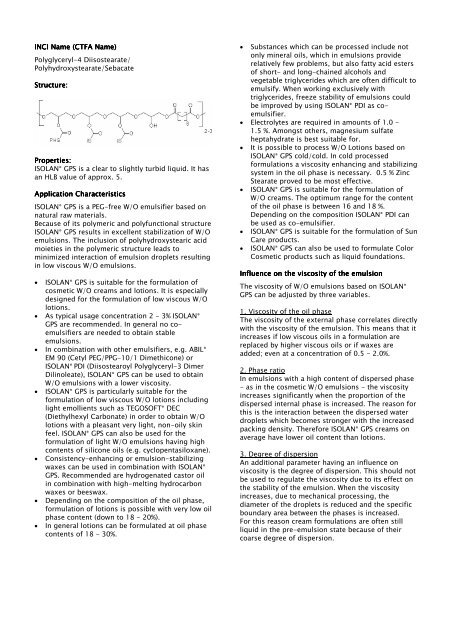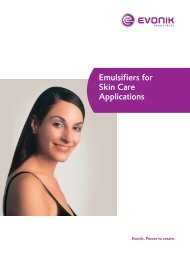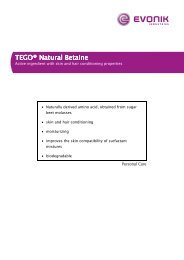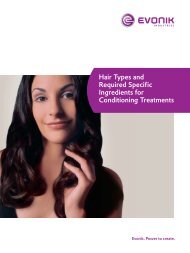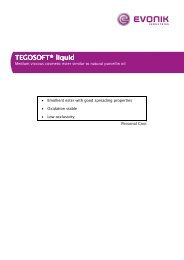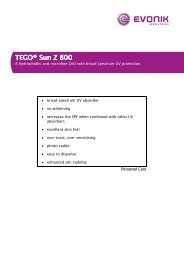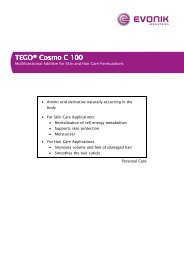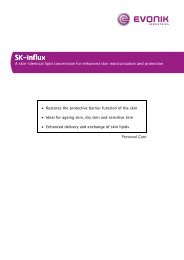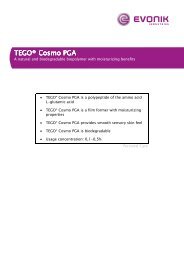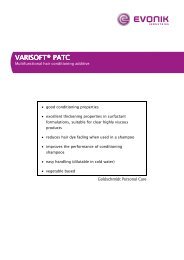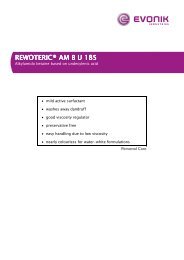ISOLAN® GPS ISOLAN® GPS
ISOLAN® GPS ISOLAN® GPS
ISOLAN® GPS ISOLAN® GPS
Create successful ePaper yourself
Turn your PDF publications into a flip-book with our unique Google optimized e-Paper software.
INCI Name (CTFA Name)<br />
Polyglyceryl-4 Diisostearate/<br />
Polyhydroxystearate/Sebacate<br />
Structure:<br />
Properties:<br />
ISOLAN ® <strong>GPS</strong> is a clear to slightly turbid liquid. It has<br />
an HLB value of approx. 5.<br />
Application Characteristics<br />
ISOLAN ® <strong>GPS</strong> is a PEG-free W/O emulsifier based on<br />
natural raw materials.<br />
Because of its polymeric and polyfunctional structure<br />
ISOLAN ® <strong>GPS</strong> results in excellent stabilization of W/O<br />
emulsions. The inclusion of polyhydroxystearic acid<br />
moieties in the polymeric structure leads to<br />
minimized interaction of emulsion droplets resulting<br />
in low viscous W/O emulsions.<br />
• ISOLAN ® <strong>GPS</strong> is suitable for the formulation of<br />
cosmetic W/O creams and lotions. It is especially<br />
designed for the formulation of low viscous W/O<br />
lotions.<br />
• As typical usage concentration 2 - 3% ISOLAN ®<br />
<strong>GPS</strong> are recommended. In general no coemulsifiers<br />
are needed to obtain stable<br />
emulsions.<br />
• In combination with other emulsifiers, e.g. ABIL ®<br />
EM 90 (Cetyl PEG/PPG-10/1 Dimethicone) or<br />
ISOLAN ® PDI (Diisostearoyl Polyglyceryl-3 Dimer<br />
Dilinoleate), ISOLAN ® <strong>GPS</strong> can be used to obtain<br />
W/O emulsions with a lower viscosity.<br />
• ISOLAN ® <strong>GPS</strong> is particularly suitable for the<br />
formulation of low viscous W/O lotions including<br />
light emollients such as TEGOSOFT ® DEC<br />
(Diethylhexyl Carbonate) in order to obtain W/O<br />
lotions with a pleasant very light, non-oily skin<br />
feel. ISOLAN ® <strong>GPS</strong> can also be used for the<br />
formulation of light W/O emulsions having high<br />
contents of silicone oils (e.g. cyclopentasiloxane).<br />
• Consistency-enhancing or emulsion-stabilizing<br />
waxes can be used in combination with ISOLAN ®<br />
<strong>GPS</strong>. Recommended are hydrogenated castor oil<br />
in combination with high-melting hydrocarbon<br />
waxes or beeswax.<br />
• Depending on the composition of the oil phase,<br />
formulation of lotions is possible with very low oil<br />
phase content (down to 18 - 20%).<br />
• In general lotions can be formulated at oil phase<br />
contents of 18 - 30%.<br />
• Substances which can be processed include not<br />
only mineral oils, which in emulsions provide<br />
relatively few problems, but also fatty acid esters<br />
of short- and long-chained alcohols and<br />
vegetable triglycerides which are often difficult to<br />
emulsify. When working exclusively with<br />
triglycerides, freeze stability of emulsions could<br />
be improved by using ISOLAN ® PDI as coemulsifier.<br />
• Electrolytes are required in amounts of 1.0 -<br />
1.5 %. Amongst others, magnesium sulfate<br />
heptahydrate is best suitable for.<br />
• It is possible to process W/O Lotions based on<br />
ISOLAN ® <strong>GPS</strong> cold/cold. In cold processed<br />
formulations a viscosity enhancing and stabilizing<br />
system in the oil phase is necessary. 0.5 % Zinc<br />
Stearate proved to be most effective.<br />
• ISOLAN ® <strong>GPS</strong> is suitable for the formulation of<br />
W/O creams. The optimum range for the content<br />
of the oil phase is between 16 and 18 %.<br />
Depending on the composition ISOLAN ® PDI can<br />
be used as co-emulsifier.<br />
• ISOLAN ® <strong>GPS</strong> is suitable for the formulation of Sun<br />
Care products.<br />
• ISOLAN ® <strong>GPS</strong> can also be used to formulate Color<br />
Cosmetic products such as liquid foundations.<br />
Influence on the viscosity of the emulsion<br />
The viscosity of W/O emulsions based on ISOLAN ®<br />
<strong>GPS</strong> can be adjusted by three variables.<br />
1. Viscosity of the oil phase<br />
The viscosity of the external phase correlates directly<br />
with the viscosity of the emulsion. This means that it<br />
increases if low viscous oils in a formulation are<br />
replaced by higher viscous oils or if waxes are<br />
added; even at a concentration of 0.5 - 2.0%.<br />
2. Phase ratio<br />
In emulsions with a high content of dispersed phase<br />
- as in the cosmetic W/O emulsions - the viscosity<br />
increases significantly when the proportion of the<br />
dispersed internal phase is increased. The reason for<br />
this is the interaction between the dispersed water<br />
droplets which becomes stronger with the increased<br />
packing density. Therefore ISOLAN ® <strong>GPS</strong> creams on<br />
average have lower oil content than lotions.<br />
3. Degree of dispersion<br />
An additional parameter having an influence on<br />
viscosity is the degree of dispersion. This should not<br />
be used to regulate the viscosity due to its effect on<br />
the stability of the emulsion. When the viscosity<br />
increases, due to mechanical processing, the<br />
diameter of the droplets is reduced and the specific<br />
boundary area between the phases is increased.<br />
For this reason cream formulations are often still<br />
liquid in the pre-emulsion state because of their<br />
coarse degree of dispersion.


